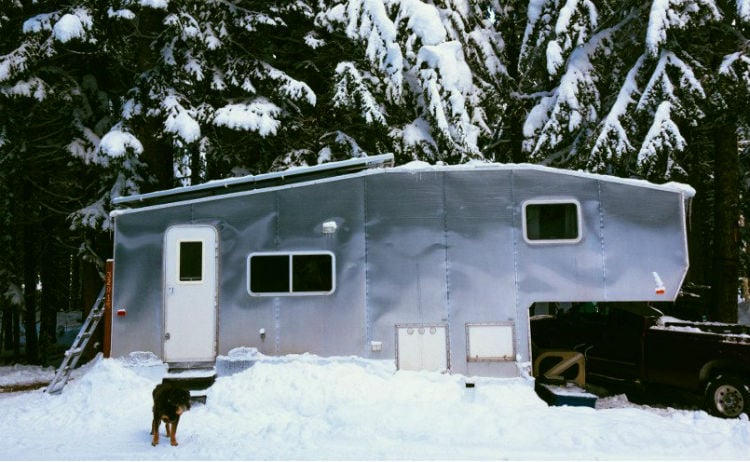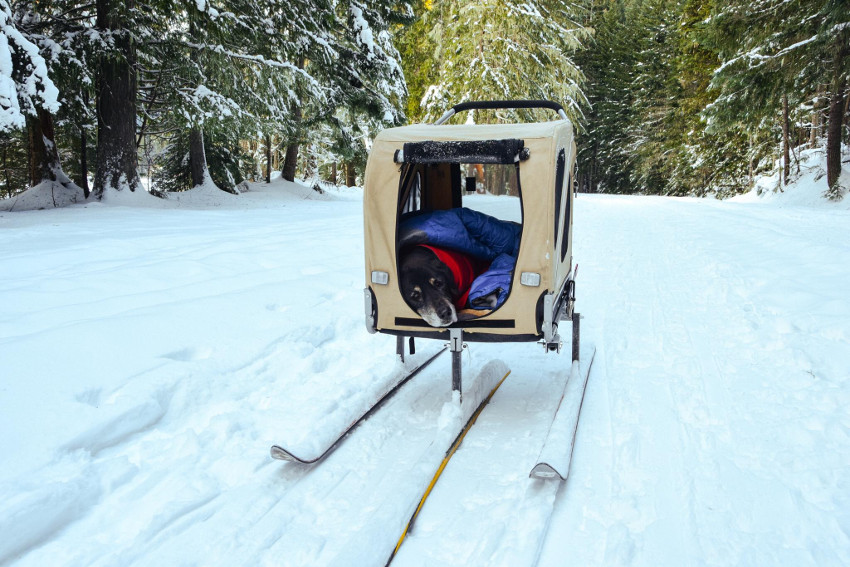What if you could go RVing in frigid temperatures but stay warm and comfy in the campground? Most campers would say “No way!” but a growing number of winter RVing enthusiasts are proving that it’s totally possible. With the right preparations, die-hard winter RVing road trippers like Ching and Jerud are having endless fun all-year.

How to avoid winter camping problems in your RV may take time, but this couple went winter RVing and loved it!
Diehard Winter RVing Campers Tell How to Do it Right
Two years ago this couple hit the road full-time in their eco-friendly fifth wheel. Last fall, they decided that instead of setting up their camp in a warm RV snowbird destination, they would go in the opposite direction. As avid skiers and snow shoers, Ching and Jerud chose to snowbird near Mount Ranier National Park. Here’s how they managed to enjoy their first snowy winter RVing experience.
What’s the coldest temperature you’ve endured so far?
Single digits – around 7 °F. We were surprised because our research (and the locals) told us that the area we were in doesn’t typically get colder than 20 degrees. But our rig was ready for those temperatures.
How are your dogs adapting? What kinds of things do you do to keep them warm and keep mud out of the RV?
Our younger dog, Tyki, loves the snow. He enjoys running through the snow and rubbing his head all over the snow-covered ground. Our older dog, Tybee, enjoys it but not as much as when she was younger. At 14 years old, she’s not as stable on her feet and the snow makes it more difficult. But Jerud rigged up her dog trailer, replacing the wheels with skis. This means we can bring her out with us for walks in the snow. When we bring Tybee out in her dog trailer, we lay a dog bed in it to keep her belly warm and on colder days we also wrap her in a sleeping bag. It’s been cold enough and enough snow on the ground that we don’t have to worry about mud.
Have you had any frozen pipes or lines? Is your winter RVing skirting doing its job?
Knock on wood, but we haven’t had any frozen pipes, water lines or fresh/gray water tanks. So far, our winter RV skirting is definitely doing the job. But we do watch the temperatures in the space under the Toaster and turn on a 500-watt halogen work light when it gets below 35 degrees. This is a conservative approach but temperatures can drop faster than the heat lamp can warm up the space.
What are your biggest lessons? Would you do this again?
Yes, we would definitely do this again! Our lessons learned include:
- Get a boot tray for wet shoes and protect (wood) floors.
- Place a rubber floor mat inside the entry to protect wood floors and keep floors cleaner.
- Don’t use your awning – they won’t hold up to snow accumulation. But at the same time, an awning or something sturdier is nice to have to cover the front door when it’s snowing.
- If you’re in an area that has snow removal, keep your personal belongings close to your rig and put poles/bamboo sticks in the snow to show where things stick out (front steps, trailer hitch, etc.) so the plows can avoid hitting them.
- Have plans for backup power even if you have shore connection. Power outage can happen and this may mean frozen pipes, tanks, etc. if you don’t have a backup to keep the rig warm. (*Ed note: properly utilizing more electrical in your RV can be accomplished by learning how to effectively maintain power when winter camping)
The remainder of Ching and Jerud’s winter RVing adventures are chronicled in their blog at LiveSmallRideFree.com.



Leave a Reply